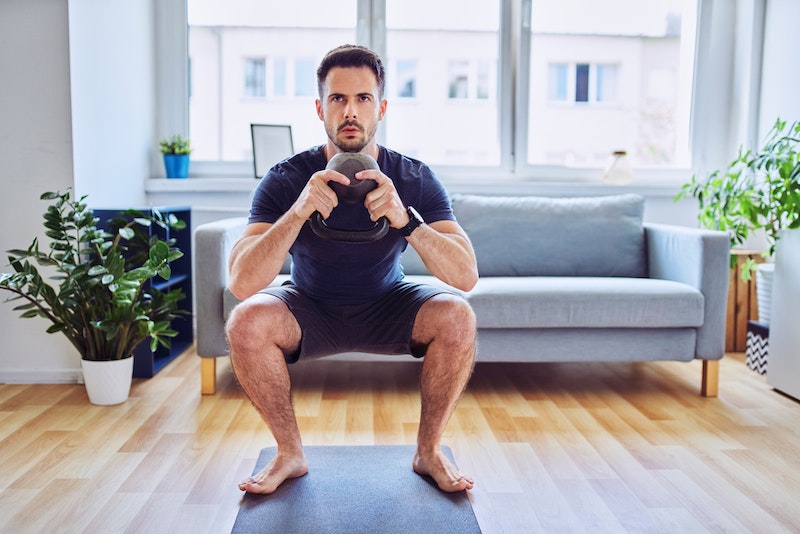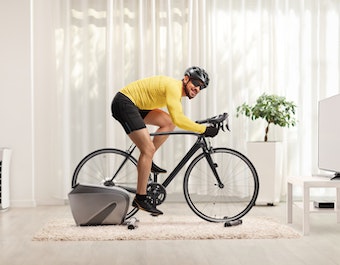Perhaps you’ve lost a few steps (or reps) since your gym closed. Or maybe you’ve become a home-gym rat during the pandemic and want to level up. Whatever the reason, if you’re looking to maximize results from the minutes you spend sweating, you’ll need to know how and when to take things up a notch.
“Keep your body guessing so it cannot fully ‘master’ the workout,” says Michele Olson, a senior clinical professor of sport science at Alabama’s Huntingdon College, and a fellow of the American College of Sports Medicine. “It keeps you in the adaptation mode, and that’s where we always realize the most benefits.”
Don’t fear: This doesn’t mean spending more time working out (in some cases, it may even mean less!), or buying a lot of expensive equipment. But it is a good idea to talk to your doctor before starting a new routine, especially if you have a health condition.
Here are four science-backed ways to keep squeezing the most from your workout.
1. Try kettlebells for strength and aerobics
The kettlebell’s shape (like a, er, kettle with a handle) means the weight is both easier to swing around than a dumbbell, and is centered beyond the user’s reach.
“The unbalanced weight of the kettlebell makes your body work in a new way,” says Olson.
Kettlebell swings are also very efficient: They’re both a cardio and a strength exercise, and they work nearly all the major muscles in the body.
“They are also easy to learn,” says Olson, who recommends fitting 10 minutes with the bells into your workout twice a week (either in place of some part of your cardio or strength, or as an addition).
Start by mastering a basic two-arm swing. Place the kettlebell on the floor slightly in front of you, hinge at the hips, grab the bell’s handle with both hands, then drive your hips forward to lift it. Your elbows should be slightly bent; you really want to be using your legs and hips to drive the motion, rather than thinking about it being an arm raise.
Safety tip: Contract your abs and buttocks as you swing and avoid leaning back, which can cause lower back pain. (If you have herniated discs or are recovering from back surgery, kettlebell swings are not for you.) For more form and other tips, watch here.
Still not convinced? A small study suggested that kettlebells improved a user’s maximum squat and vertical jump, and there is evidence they improve weightlifting performance, giving you the kind of workout that would otherwise require more equipment than anyone but a professional athlete might have at home. Another small study found that two kettlebell workouts a week improved strength and aerobic capacity, and boosted core strength by a whopping 70 percent.
2. Throw in some intervals for efficiency
You’ve probably heard of some of the benefits of now-trendy high-intensity interval training (HITT) — it is more effective than steady-state exercise at increasing aerobic capacity, and can help reduce blood pressure.
But there also has been a lot of fuss about exactly how intense a HIIT workout should be. Forget exact measures, says Martin Gibala, a professor of kinesiology at McMaster University in Canada, who has done multiple studies on interval training — and who became a fan himself when he had two young children and a working spouse and found himself with very little time to exercise.
All you have to do to reap the benefit is “just get out of your comfort zone and feel a little bit more out of breath,” says Gibala. This can run the gamut from a slow walk with some brisk walking incorporated, all the way up to a sprint-from-danger pace. One study found that intermittent walking boosted the study participants’ blood sugar control, and it was associated with some favorable changes in body composition.
Intervals are also terrifically efficient: In a 2016 study of Gibala’s, one group worked out for just 10 minutes total (mixing in three 20-second sprints that added up to one measly minute of all-out effort), and the other for 50 minutes at a continuous pace. The two groups of exercisers saw the same improvement in their oxygen uptake, despite the vastly different time commitment. (The more oxygen your body can take in, the better your fitness.)
Another benefit of interval training: You can vary it endlessly. There are only so many ways to jog at a moderate pace for 45 minutes, but with intervals you can vary your absolute intensity (how hard you push during the interval), how long your interval is, how long your recovery is and what the recovery is (easy or moderate pace.)
For example, Gibala says some days he will do a half hour of 30 seconds really hard, 30 seconds recovery; other days it will be four minutes on, two minutes off (obviously at a less intense pace than what he’d do for the all-out 30 seconds.) “Both of these are getting at my muscles in very different ways,” he says. If you’re new to interval training, start gently, listen to your body, and don’t do more than two hard interval workouts a week.
3. Start weight-lifting to boost your burn
You don’t even need to buy weights!
Strength training can improve markers of heart health (such as improvements in blood lipids), Olson says, and it can also help you burn more calories than just cardio because of what’s known as the exercise post-oxygen consumption (EPOC), or calorie afterburn. Studies have shown that resistance training leads to a larger calorie afterburn than running at a steady pace.
Federal guidelines recommend two strength training sessions a week. And you don’t need to spend hours pumping iron to get results. A small 2019 study suggested just 13 minutes could be effective, if you “work to failure” –– which means lifting enough weight that you can only finish one 8-to-12 rep set.
If you don’t have weights, you can make body-weight exercises more difficult by elevating your feet during a pushup, or increasing so-called time under tension — doing, say, a four-second count on the way down for a squat. “The last few reps need to be difficult to complete,” says Brad Schoenfeld, an associate professor of exercise science at Lehman College in the Bronx, NY, and the study’s lead author.
For a cycle that hits the entire body, Olson suggests squats, pushups, dips, lunges, and some type of pulling exercise, such as rows or lat pulldowns.
4. Work out with a friend for accountability (virtual counts)
Many people who exercise at the crack of dawn know that having a friend waiting can mean the difference between getting out of bed and hitting snooze.
But working out with a buddy can also make you exercise harder and longer. And yes, this effect has been replicated with virtual buddies: In a 2013 study, participants with online pals held planks for 24 percent longer than those working out alone.
Bonus points if your friend is fitter than you. In a 2020 study, adults doing sprints on a cycle ergometer always worked at least a little harder when they were paired with an on-screen partner who was more fit, but the difference was particularly pronounced on the hardest intervals. The study happened to be published during the pandemic, when a lot more people might need virtual partners, but it was sponsored by NASA with the intention of helping people used to long periods of isolation: astronauts.
If you can round up a regular partner or two, Olson suggests taking turns planning the workouts and then meeting in the park, or on or your virtual platform of choice. (Just pay attention to your local health recommendations.)
Variety, endorphins, and connection –– isn’t 2021 looking better already?
COURTNEY RUBIN
Rally Health





